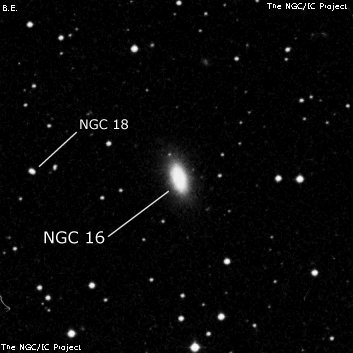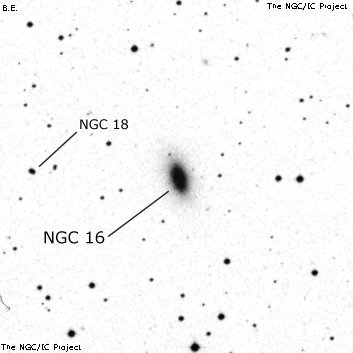NGC/IC Project Restoration Effort
(This is a very very beta version)
NGC16


Basic Information
Location and Magnitude
Right Ascension: 0:9:4.2
Declination: +27:43:48
Constellation: PEG
Visual Magnitude: 12.0
Historic Information
Discoverer: Herschel J.
Year of discovery: 1828
Discovery aperture: 18.3
Observational
Summary description: pB, S, R, bM
Sub-type: E/SB0
Corwin's Notes
=====
NGC 16 = H IV 15 = h 4 = h 5. Here is a peculiar case where both WH and JH
have enough problems in their observations that Wolfgang Steinicke has
suggested that JH actually saw NGC 22 in one of his observations rather than
the much brighter galaxy that his father found. Courtney Seligman brought
this to my attention in April 2015; see his web page on the object for his
take on the problems.
WH first saw this on 8 September 1784 and put it 2 minutes 6 seconds east of,
and 1 degree 21 arcminutes south of alpha Andromedae. There is nothing there.
But about 1 minute and 24 seconds west is found a galaxy more or less matching
his description in CH's fair copy: "Stellar, or rather like a faint star with
a small chevelure and two burs [sic]. F, S." There are a couple of
additional things to note. First, there is another star in the sweep, 85
Pegasi that gives a different RA zero point. Using that, the position for
WH's object becomes just 1 minute 6 seconds west of the galaxy. This is
strongly suggestive of a simple digit error in WH's observation.
The next observation was by JH on 5 September 1828. This pinned down the
galaxy very well, but JH added a note in parentheses to his observation, "(?
[query] if not IV 15)", well aware that his position was well off his
father's.
JH went over the field again on 16 September of the same year, but recorded
only an approximate position for the object, calling it "A star 15m with a
burr AR [sic] from Cat." So, he accepted that he had seen the same object
in this sweep that his father had, even to the extent of adopting the RA from
his father's list. There is, of course, nothing in this position.
And this is where the trouble really sets in. JH enters the two observations
in his own 1833 list as two separate objects, and copies both into the GC.
d'A comments that he cannot find GC 12 = h 5 on three of the five nights that
he observed an object which he called H IV 15 = h 4, not following JH's own
list where he (JH) put IV 15 = h 5. JH has a rather peeved note in GC about
this: "D'Arrest says, 'h. II. positio cert erronea,' but gives no indication
of the correction required in R.A. or P.D."
Dreyer finally sorts it all out for the NGC by making IV 15 = h 4 = h 5,
adopting something of a mean of JH's and d'A's positions, and adding a note,
"h 5 was not seen by d'A [3 nights] and St[ephan] (XIII) [2 nights]; it is
= h 4 as they were observed in different sweeps." In his 1912 edition of WH's
complete scientific papers, he adds "IV 15 is = h 4, 1m 20s p[receding] H's
place. Some error in recording the transit, probably of 1m; reductions
correct."
So there matters stood until Wolfgang went over the field during his
re-evaluation of WH's observations and decided that IV 15 = NGC 22. He also,
in his re-evaluation of JH's observations, has h 5 identical to a star at
00 10 28.0, +27 42 00 (there are neither stars nor galaxies there). I have
not yet had any correspondence with him about this; but given that WH's
declination is off NGC 22 by 7 arcmin, and that a simple 1 minute of time RA
error will explain the difference in position with NGC 16 -- well, I find
myself agreeing with Dreyer on this one.
Steve's Notes
=====
NGC 16
17.5" (11/14/87): moderately bright, fairly small, oval SSW-NNE, small bright core, stellar nucleus.
17.5" (9/19/87): fairly bright, moderately large, elongated ~N-S, bright core, stellar nucleus. NGC 22 lies 12' NE.
13" (8/24/84) : moderately bright, small, bright stellar nucleus, small fainter lens SSW-NNE.
8" (8/16/82): fairly faint, small, elongated N-S, bright nucleus at 200x.
8" (6/19/82): fairly faint, small, slightly elongated N-S, weak concentration.



